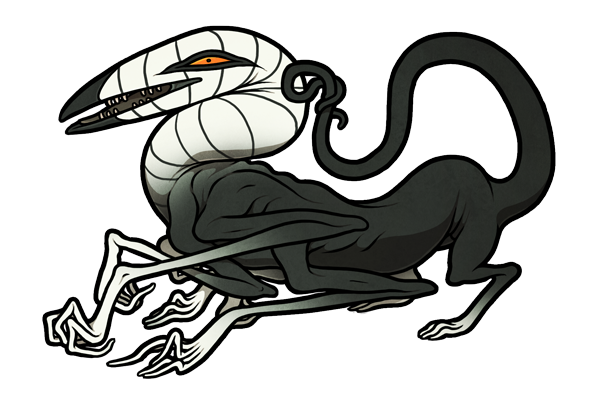

skendrelli
the ticklers
prefix sken suffix drelli
gorias prelac
physical appearance
The skendrelli /skɛnˈdɹɛli/ skendrelli is a thin-snouted stranger with three pairs of elongated, slender-fingered forelimbs and a pair of smaller hind limbs. It bears pale ”cowl-and-glove" markings, decorated with thin black stripes around the head that grow darker over the skendrelli's life. Its skin carries no heat, and carries the paradoxical texture of being both soft and hard when touched, though the former (if more silicon than skin) by all evident means. When pressed from outside, the skendrelli's flesh offer fibrous resistance. Cutting the stranger reveals dry and many-layered folds of flesh that overlap and merge in a pattern radiating outward from its center.
The skendrelli's breath is stale, its teeth coated with venomous fluid compositionally analogous to neutral sphingomyelinase. The skendrelli's oral tissues are flesh-like (even bearing the ability to salivate a watery fluid that seems to contain small grit particles), and its throat connects directly to its inner tissues, which are soft enough to part in the case of intrusions.
Possessing no language of its own, the skendrelli instead mimics human speech, its voice raspy and clicking. Each statement is followed by an out-of-breath gasping of equal length.
You don't need to - alright, you don't need to.

environment and generation
The skendrelli generates in long-incomplete construction projects. Among the exposed frames, sedimentary layers of dust, and piles of board and rebar of these anticipatory buildings, it scuttles in bursts from beneath anything which offers it a lightless point of generation, its size mature at formation.
behaviour and effects
The skendrelli possesses a surreptitious nature despite its gangly size. When it first appears, it makes no sound and it moves through the shadows and shies away from light and sound, moving towards a place in which to establish its territory. In its search for a suitable location, it prefers dry warmth, exposed wood, and avoids exposure to movement and incandescence.
Upon finding a location of potential size and seclusion, it explores the environment in detail, moving on in 12% of instances, but otherwise finding a point in which to establish its body compactly, its fingertips tracing into the wood with a silent scrape. The skendrelli finds its footing even when positioned upside-down, bracing itself in ceiling corners or among rafters when unable to find an open duct or narrow closet.
Within these spaces, it lies in wait, its arms bunched at the shoulders and elbows, the other joints otherwise splayed outwards. It keeps its shoulders tucked low and its head angled back or upward, its attention remaining alert for changes.
Though its repetitive tapping eventually cause the characteristic "tickler's scrapes"ǂ of a skendrelli infestation, it otherwise moves from this spot only to gather string, nails, splinters, or other small objects. Strings are tied horizontally across the bottoms of doors, nails are placed sharp-side up, splinters are lodged between floorboards, and other traps are placed in a similar manner. Upon establishing such a trap, the skendrelli returns to its site of surveillance.
ǂ There! At the wall. There must be a hundred of them! How could we have missed them before?
Yaron Yarzovzcy. Paravault #8.
interactions between individuals
Though ambivalent to both animals and other strains (moving away from or growing compact when faced with larger animate forms), the skendrelli is strictly solitary towards others of its kind.
interactions with sensitives
The skendrelli watches sensitives without moving. It attempts to avoid light, shrinking back or abandoning its post altogether when its environment becomes illuminated. Very bright light (particularly the directional beams of high-powered flashlights) can stupefy it altogether, and a skendrelli quieted in such a way even tolerates some handling without apparent discomfort.Ẕ
Should the sensitive disturb the stranger, or become incapacitated within the skendrelli's close vicinity, the stranger rushes outwards, grabbing onto the sensitive and pulling them towards cover. Despite its predatory nature, the skendrelli lacks a tendency towards overt violence, instead, uses its long arms to restrain the sensitive, tracing its long fingers across their face, and breathing or whispering in the sensitive's ear. The skendrelli positions itself carefully so as not to crush its prey beneath its weight. Its strength is comparable to an adult human of above-average physical prowess.
These attacks last anywhere from thirty seconds to six minutes. Despite its size and strength, the skendrelli does not tend to cause anything beyond bruises or minor scrapes, with most injuries being sustained as a result of the sensitive's struggling. Once the skendrelli is sated in its interest, it recedes to the shadows once more, and displays only peripheral interest in the sensitive for the remainder of the encounter.
Significant impacts to the skendrelli's body cause its frame to crumple and become as soft and limp as a stuffed doll, no longer bound to any particular structure despite its otherwise jointed appearance, a state that it remains in for up to an hour. If cut or otherwise wounded, however, it retaliates with a series of quick bites, its venomous bite causing rigidity in motion and a locking of the limbs in a fetal, protective posture.
Though the skendrelli sets traps, it displays little more than passing interest in their "success."
aging and death
As the skendrelli ages, its stripes become fully opaque. As they do, so too do these areas seem tender to the touch, even a light brushing of gauze causing the stranger to recoil and hiss. This sensitivity restricts by the day the skendrelli's movements and behaviour, as it abandons its trap-checking and even eschews aggression towards sensitives, its stillness of motion favorable to what seems to be increasing pain. After under a week of such avoidant behaviour, the skendrelli finally dies with an outward shudder and a quick wrinkling of the skin.
A skendrelli's corpse does not rot, but instead, gradually loses bulk and weight, its inner flesh parting and shifting with the dissipation of its internal structures. It loses all color, becoming translucent, and within a week, becomes a brittle shell that can be split apart easily.



